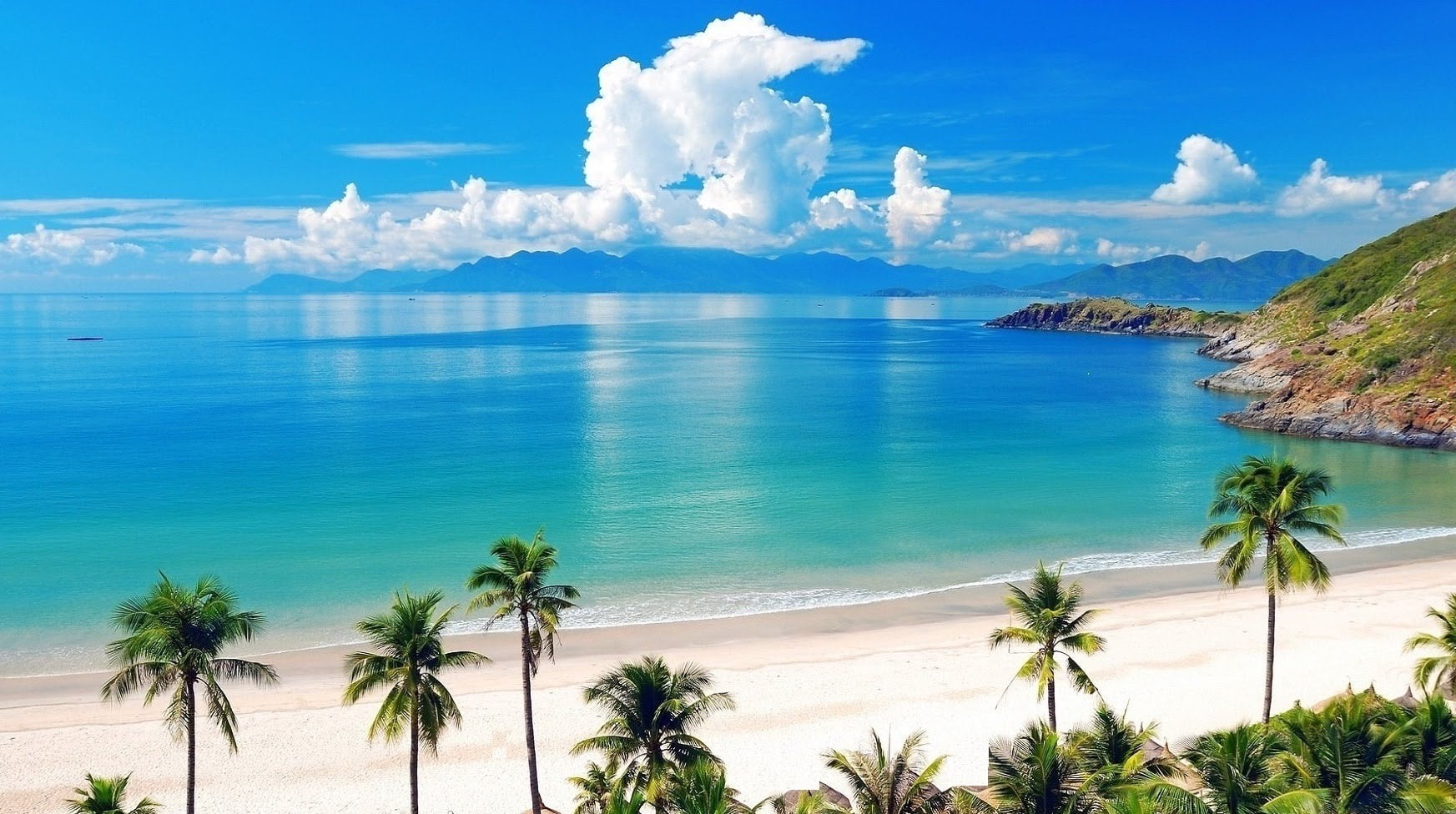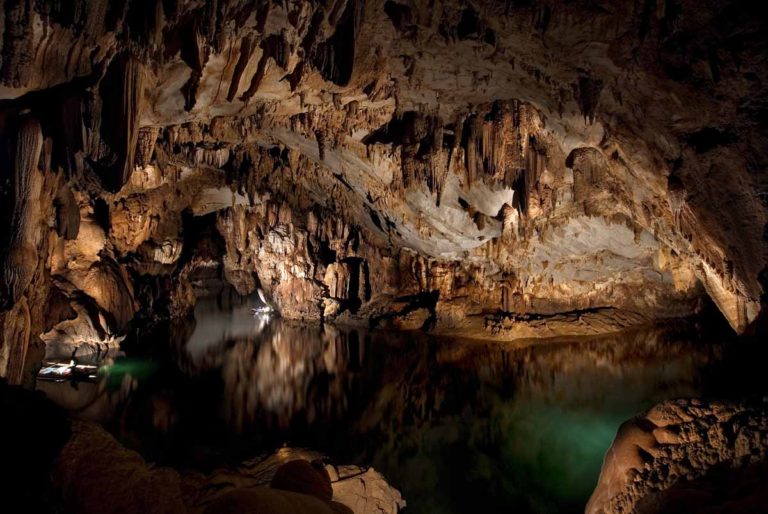Palawan Island is the largest island in the province of Palawan in the Philippines. It is a long island, the fifth largest in the Philippines, running in a north-east to south-west direction with the South China Sea to the north-west and the Sulu Sea to the south east. It is around 450 kilometres long and 50 kilometres wide. This part of the world has no shortage of beautiful islands but Palawan Island seems to fulfil most people’s ideals when looking for a true tropical paradise. Although a popular tourist destination, Palawan Island has remained undeveloped its attractions relying on its sheer natural beauty. It not only offers white sandy beaches but also has mountains, jungles and an amazing range of wildlife. The steep-sided mountains rear up out of the sea to an average height of 1,100 metres with the island’s highest peak, Mount Mantalingaham reaching 2,086 metres. The waters around Palawan Island are just as awe-inspiring with coral reefs and atolls, rocky coves and caves and even an underground river.


History of Palawan Island
Archaeological studies have revealed that this island has been inhabited for at least 50,000 years and it is commonly believed that the first settlers probably came from Borneo but the island’s central location among many different cultures has resulted in influences from many other places. Around 220 – 263 AD it is recorded that “little dark people” were driven south out of China and some of these displaced people almost certainly settled on the island probably being the direct ancestors of Palawan’s Batak tribe. The 12th century saw the arrival of Malay immigrants followed by Indonesians in the 13th century. Spain later claimed the territory until it came under American rule in 1902. Puerto Princesa was declared to be the capital city in 1903. During the Second World War it was invaded by the Japanese and Puerto Princesa was the site of the infamous Palawan massacre when prisoners of war were herded into petrol filled trenches and burned to death. Today the island is a much more peaceful place but still demonstrates amazing cultural diversity with over 87 different cultural groups and 52 different languages and dialects being spoken the most common being Tagalg. Roman Catholicism is the most widely practised religion but, with such cultural diversity, many other religions are also followed.
Palawan Island Climate
At a latitude of nine and a half degrees north of the equator this is a true tropical island and the average temperature is 31 degrees Celsius and there is little variation in temperature throughout the year. There are seasonal variations in rainfall however and the weather patterns vary according to which side of the island is being considered. The east coast facing the Sulu Sea has a dry season of between one and three months with intermittent rainfall during the rest of the year. The west-facing South China Sea coast however has rather more extreme patterns of precipitation with a six month dry season and six month wet season. This pattern also extends to the northern and southern extremities of the island. The north in particular is affected by torrential rains during July and August.

Palawan Island Flora and Fauna
Islands are fascinating places where evolution often leads to distinctive individual species not found elsewhere but Palawan’s relatively close proximity to other territories has resulted in much of the vegetation being similar to that of Borneo with birds being responsible for much of the seed dispersal. The island does however have some unique species such as purple crabs or the recently discovered carnivorous shrew-eating pitcher plant Nepenthes attenboroughii (named after the famous naturalist Sir David Attenborough). The Palawan peacock-pheasant is one of the island’s native species and a vast range of over 200 species of birds can be found along with 1,500 different plants and the island is also home to 600 different species of butterflies.
Protection of Palawan Island
This is a place that has a long history of being regarded as an island paradise. Although there are some important industries such as forestry, most people still think of this as the land of the pearl divers. Pearl diving did indeed generate some useful income in the past but this is no longer a common occurrence. The waters off Palawan Island were the source of the world’s largest pearl which was found in 1934 and had a diameter of 9.4 inches.

The Island has been named as the world’s most beautiful island on more than one occasion based on votes cast by readers of Travel &Leisure and Conde Nast Traveller and the acclaimed undersea naturalist Jacques Cousteau described the waters around the island as being one of the most beautiful seascapes in the world. Palawan Island has been designated by UNESCO as being of Biosphere Reserve status since the early 1990s meaning that it is not only a place practising the principles of conservation but also a living laboratory where long-term studies can be carried out for the benefit of this and many other places around the world.
El Nido
Any visit to Palawan Island would be incomplete without spending some time at El Nido. The name comes from the Spanish for “The Nest” and it is a town which stands at the gateway to the Bacuit archipelago at the northernmost extremity of the island. This is the home of some truly spectacular scenery both above and below the sea. It forms the El Nido Marine Reserve Park with such endangered species as the giant clam. Philippine cockatoos have also recently been reintroduced. The nearby Tubbataha Reef Marine Park, established in 1993, is also incredible covering an area of 332 square kilometres it includes north and south reefs (atolls) and various islets. The north islet is an important breeding ground for birds and turtles and features a pristine coral reef and a 100 metre vertical wall. There are also several other coral islands and lagoons.

Puerto Princesa Underground River
Another remarkable place to visit is the five mile long underground river at Puerto Princesa which flows directly into the sea meaning that the lower reaches of the river are subject to tidal changes of water level. This is the second-longest underground river in the world. This unique feature is recognised as being one of the natural wonders of the world and in 1999 UNESCO listed the Puerto Princesa Subterranean River National Park as a World Heritage Site.

Visiting Palawan Island
Palawan Island may seem like a remote inaccessible place but it is now remarkably accessible both by sea and air. Flights from Manila normally take less than 90 minutes and there are many other points of departure. So for those dreaming of swimming with turtles in crystal clear lagoons or simply wishing to catch sight of a Philippine mouse deer or purple crab, this is the place to go. Almost everyone will welcome their stay on the island but there are some exceptions and it is worth remembering that Palawan Island also has some more reluctant visitors at the Iwahig Prison and Penal Farm which is located on the island.

The Future of Palawan Island
This island is ecologically very important and this is recognised both locally and internationally so any future development is likely to be very closely monitored and controlled. It is one of the few tourist destinations not to have been over-developed and it has retained all of its natural beauty. The coral ecosystems are thriving but, like all corals, are extremely vulnerable to changes of any kind. There have been recent plans for a naval base to be established in the Oyster Bay area but this may or may not happen. If such plans do go ahead, great care will need to be taken to minimise any potential damage to this wonderful place. A trip to Palawan Island is likely to be an unforgettable experience and for lovers of nature this could prove to be one of the best places in the world.



Does anyone know what the coral health is like this year? I want to visit but I don’t want to go if there has been recent bleaching.